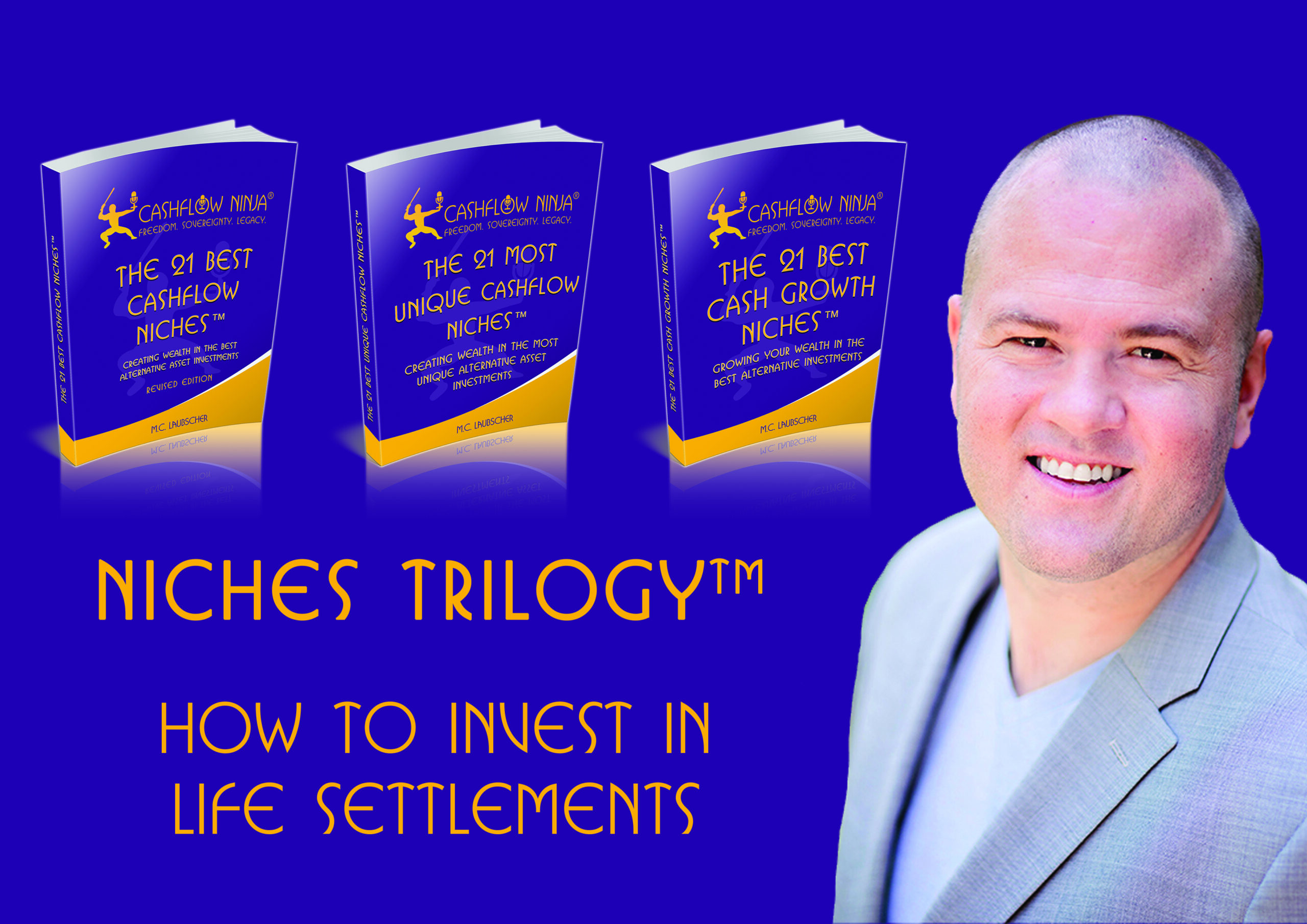
Life settlement investments involve purchasing life insurance policies from policyholders who no longer want or need them. Typically, these policyholders are seniors looking to access cash from their policies while still alive.
The Security and Exchange Commission defines a life settlement as follows. “In a ‘life settlement’ transaction, a life insurance policy owner sells their policy to an investor in exchange for a lump-sum payment. The payment from the investor to the policy owner is generally less than the death benefit on the policy but more than its cash surrender value.”
In a life settlement transaction, the policyholder sells their life insurance policy to a third party for more than the policy’s cash value but less than the death benefit. The buyer takes over the premium payments and receives the death benefit when the insured person dies.
So, what is the process of life settlement investments like? It begins with the identification of policies available for sale. Investors leverage brokers and providers to see what policies are available to buy.
Once a policy catches their eye, investors must then determine its worth. They’ll consider the death benefit, the insured person’s health status, life expectancy, and future premiums. Each of these elements contributes to the overall valuation.
With a clear understanding of the policy’s value, the investor can make an informed purchase at an agreed price. At this point, they take on the responsibility of paying the premiums.
To maximize returns, investors actively manage their investments. They ensure that premiums are paid on time and closely monitor the insured person’s health. Sometimes, they may even diversify their portfolio with multiple policies.
The final step in the process is when a policy matures, resulting in a payout. When the insured person passes away, the investor collects the death benefit.
At first glance, life settlements almost sound too good to be true, and most investors will pause and ask, “How is this even legal?”
In a Supreme Court ruling dating back to 1911, Justice Oliver Wendell Holmes. Jr. delivered the majority opinion that would lay the groundwork for life settlement investments. The ruling came in the case of Grigsby vs. Russell, establishing life insurance contracts as saleable assets.
R. L. Russell was the executor of John Burchard’s estate. Burchard had passed away about a year after an operation. However, to afford the operation, Burchard had sold his life insurance policy to Dr. Grigsby in exchange for the operation plus $100.
When the insurance company paid Dr. Grigsby instead of the estate, Russell filed suit to have the proceeds paid to the estate. The case went to the Supreme Court, which affirmed that Burchard had the legal right to sell his policy and Grigsby had the right to purchase it. The essential issue at the heart of the opinion delivered by Justice Holmes is contained in this brief excerpt:
“Life insurance has become in our days one of the best-recognized forms of investment and self- compelled saving. So far as reasonable safety permits, it is desirable to give life policies the ordinary characteristics of property …. To deny the right to sell except to persons having such an interest is to diminish appreciably the value of the contract in the owner’s hands.”
Today, life settlement investments are popular with institutional investors and very elderly or unwell seniors who wish to sell their insurance policies.
Institutional investors know the power of life settlement investments.
They have utilized the vehicle in their strategy since it allows them to buy their equity when they buy. Many billionaires, such as Warren Buffet and Bill Gates, like a sure thing. They do not overcomplicate anything. This is why Berkshire Hathaway invests more than $600 million annually in life settlements. Buffet even owns a private company that sells life settlements. Bill Gates has over $400 million in life settlement investments in his portfolio, which he adds yearly.
Why Invest in Life Settlements?
Life settlements offer a non-correlated asset class less influenced by stock market fluctuations, interest rate changes, and economic cycles.
It provides exceptional diversification in a well-balanced portfolio.
Compared to traditional fixed-income investments, returns can be attractive, especially in a low-interest-rate environment.
The life settlements market is growing due to an aging population, providing more investment opportunities.
Life settlements allow investors to invest in life insurance policies with a contractual payout from a top-rated life insurance carrier when the insured person passes away.
Each underlying asset carries the written guarantee of a top-rated American life insurance company.
Why Would Someone Sell Their Life Insurance Policies?
People would sell life insurance policies when their family does not need the protection anymore or can no longer afford the premiums.
People may prefer to sell their life insurance policy rather than continue to pay the costly premiums with money that they could direct toward health care bills.
People who sell businesses may no longer need a life insurance policy to protect their partners or investors. Furthermore, suppose the business was paying the premiums on that policy. Then, they may no longer be able to pay for it either.
People might need more money for retirement. An unneeded life insurance policy may be able to be sold for immediate cash, producing some retirement funds for them to take a dream vacation or purchase the perfect house.
People also sell their life insurance when they have a terminal illness.
They may use the money to live out the remainder of their lives comfortably. Or, they may need money to be able to afford medical care as well as their house.
People selling their policies are in a better position than before selling.
On average, policy owners receive four to seven times more from a life settlement selling their life insurance policy than they would have received from surrendering it to the insurance company.
Life Settlement Ecosystem
The life settlement ecosystem is a complex and multifaceted market involving various participants and governed by stringent regulations. The key participants include sellers, typically seniors who no longer need or can afford their life insurance policies, and buyers, such as institutional investors like hedge funds, banks, or life settlement companies.
Intermediaries, including brokers and providers, facilitate the transaction, while service providers such as underwriters, actuaries, legal advisors, and servicing companies offer essential support services.
This ecosystem is heavily regulated in the U.S., with laws and regulations varying across states, primarily aimed at protecting the policyholder and ensuring transparency.
How To Grow Cash
Investing in life settlements involves earning profits from the death benefit of an insured person’s life insurance policy.
Your return hinges on the gap between the total amount invested in the policy, including its purchase price and ongoing premium payments, and the death benefit received.
Several factors influence the profitability of such investments. These include the policy’s purchase price, the death benefit’s size, the insured’s life expectancy, the frequency and amount of premium payments, and the timing of the death benefit payout. Other factors like transaction and management costs, interest rates, regulatory changes, tax implications, market demand, and diversification strategy also play a crucial role.
Ethical considerations are essential, and profit is realized when the death benefit is paid out upon the insured’s passing.
For investors, particularly those outside institutional circles, there are a few ways to engage in this asset class: direct purchases of life insurance policies, direct fractional life settlements where a policy is divided among several investors, and life settlement private equity funds, offering diversification and potentially more predictable returns.
These options vary in terms of capital requirements and the level of investment expertise needed.
How to Lose Money
Investing in life settlements carries several risks, much like any investment. One major challenge is if insured individuals live longer than expected, leading to higher premium payments and reduced returns.
Premium payments can also increase over time, potentially offsetting benefits if not correctly anticipated. Incorrect valuations of policies or life expectancies can result in overpayment and lower profits.
Regulatory changes in the life settlement industry can affect costs and legality, impacting profitability. Economic shifts and interest rate changes can influence the cost of capital and future policy cash flows.
The insurance company’s insolvency, although rare, is a risk that could affect the payout of the death benefit.
Investors also face potential unexpected tax liabilities, liquidity risks, and management and transaction costs that can accumulate and diminish returns.
The life settlement market can be prone to fraud and transparency issues, necessitating thorough research and informed decision-making.
Positives & Negatives Of Life Settlements
Positives:
Non-Correlation with Traditional Markets: Life settlements are not directly tied to stock, bond, or real estate markets, offering diversification benefits.
Predictable Returns: With actuarial analysis, investors can forecast potential returns based on life expectancy estimates, though there’s no guarantee.
Potential High Returns: Returns can be attractive depending on how long the insured lives compared to the life expectancy projections.
Growing Market: As the population ages, particularly in countries with substantial elderly demographics, the market for life settlements grows.
Transparency: Regulatory oversight in the life settlements industry has increased, leading to more standardized practices and disclosures.
Liquidity Options: While traditionally an illiquid asset, secondary markets and platforms now allow for fractional ownership and increased liquidity.
Negatives:
Long Investment Horizon: It might take years to realize returns, and the outcome is still being determined since it’s based on an individual’s lifespan.
Risk of Extended Longevity: If the insured lives much longer than expected, the costs of maintaining the policy (paying premiums) can erode anticipated returns.
Regulatory Risks: The life settlement industry faces regulatory scrutiny. Changes in regulations could impact the attractiveness of investments.
Lack of Standardization: The industry needs complete standardization, making it challenging to compare investment opportunities sometimes.
Limited Historical Data: The industry, in its current form, is relatively young, limiting the amount of long-term performance data available for analysis.
Complexity: Life settlements require understanding actuarial tables, life expectancy assessments, policy details, and more.
Potential for Fraud: As with any investment, there’s potential for scams or misrepresentations, necessitating thorough due diligence.
Tax Implications: The tax treatment of life settlements can be complicated, and potential changes to tax laws can affect post-tax returns.
Investment Opportunity Filter™
The Investment Opportunity Filter™ evaluates an investment opportunity based on cashflow, tax benefits, appreciation, and the leverage it provides.
life settlements score a 2/4 with The Investment Opportunity Filter™
Life settlements can significantly increase the value and allow leveraging others’ skill sets, capabilities, networks, and capital.
You can access a webinar at www.cashflowninja.com/lf to learn more about life settlements.
Download all the Niches Trilogy Books:
The 21 Best Cashflow Niches
Digital: https://www.cashflowninjaprograms.com/the-21-best-cashflow-niches-book
Audio: https://podcasters.spotify.com/pod/show/21-best-cashflow-niches
The 21 Most Unique Cashflow Niches
Digital: https://www.cashflowninjaprograms.com/the-21-most-unique-cashflow-niches
Audio: https://podcasters.spotify.com/pod/show/21-most-unique-niches
The 21 Best Cash Growth Niches
Digital: https://www.cashflowninjaprograms.com/the-21-best-cash-growth-niches
Audio: https://podcasters.spotify.com/pod/show/21-cash-growth-niches
Listen To Cashflow Ninja Podcasts:
Cashflow Ninja
https://podcasters.spotify.com/pod/show/cashflowninja
Cashflow Investing Secrets
https://podcasters.spotify.com/pod/show/cashflowinvestingsecrets
Cashflow Ninja Banking
https://podcasters.spotify.com/pod/show/cashflow-ninja-banking
Share This
Related

895: Josh McCallen: Why Airbnb Gurus Are Shifting To Boutique Hotels
My guest in this episode is Josh McCallen. Josh is a nationally recognized hospitality executive, conference speaker, innovator, builder & investor with a track record for developing exceptional resort properties and growing world-class operational teams. Josh is also one of the principals of Accountable Equity, an investment firm that specializes in historic resort communities and…

894: Michael Mathe: Private Lending In The Luxury Real Estate Market
My guest in this interview is Michael Mathe. Michael is an investor and entrepreneur. Michael’s businesses Little Pink Houses Of America and VIP Financial Education, provide amazing business opportunities and financial education. Links: Prefer Access Website: https://www.preferaccess.com/ preferninja@vipfinancialeducation.com Subscribe To Our Weekly Newsletter: The Wealth Dojo: https://subscribe.wealthdojo.ai/ Download all the Niches Trilogy Books: The 21…

893: Josh Clayton, Kirk Martin, Alec Roth: How To Invest In Movies
My guests in this episode are Josh Clayton, Kirk Martin, and Alec Roth from Firebrand Media Group. In this episode, they share how to invest in movies. Interview Links: Firebrand Media Group https://www.fmgfilms.com/ Billy Night Subscribe To Our Weekly Newsletter: The Wealth Dojo: https://subscribe.wealthdojo.ai/ Download all the Niches Trilogy Books: The 21 Best Cashflow Niches Digital:…
